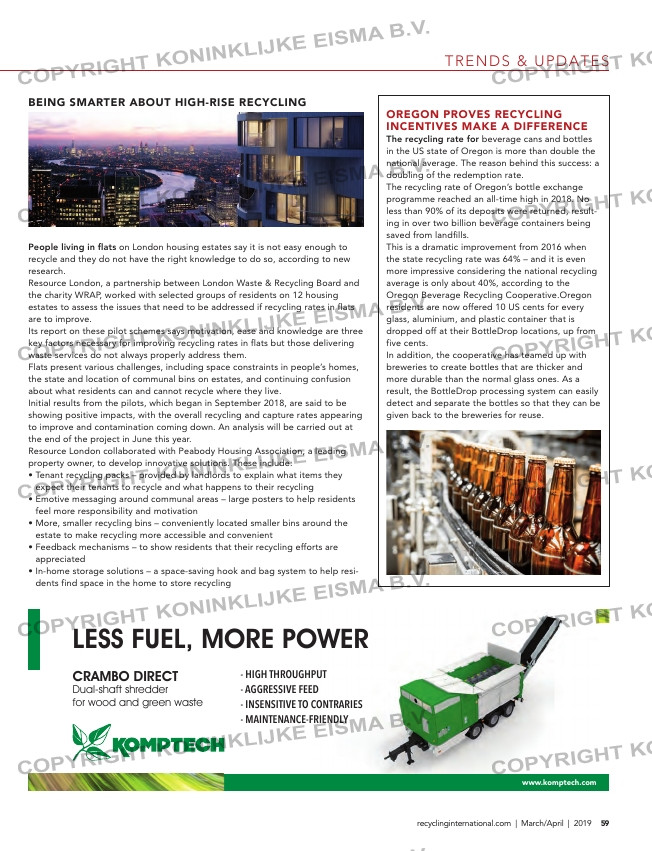Page 59 from: New issue out now!

being smarter about high-rise recYcling
People living in flats on London housing estates say it is not easy enough to
recycle and they do not have the right knowledge to do so, according to new
research.
Resource London, a partnership between London Waste & Recycling Board and
the charity WRAP, worked with selected groups of residents on 12 housing
estates to assess the issues that need to be addressed if recycling rates in flats
are to improve.
Its report on these pilot schemes says motivation, ease and knowledge are three
key factors necessary for improving recycling rates in flats but those delivering
waste services do not always properly address them.
Flats present various challenges, including space constraints in people’s homes,
the state and location of communal bins on estates, and continuing confusion
about what residents can and cannot recycle where they live.
Initial results from the pilots, which began in September 2018, are said to be
showing positive impacts, with the overall recycling and capture rates appearing
to improve and contamination coming down. An analysis will be carried out at
the end of the project in June this year.
Resource London collaborated with Peabody Housing Association, a leading
property owner, to develop innovative solutions. These include:
• Tenant recycling packs – provided by landlords to explain what items they
expect their tenants to recycle and what happens to their recycling
• Emotive messaging around communal areas – large posters to help residents
feel more responsibility and motivation
• More, smaller recycling bins – conveniently located smaller bins around the
estate to make recycling more accessible and convenient
• Feedback mechanisms – to show residents that their recycling efforts are
appreciated
• In-home storage solutions – a space-saving hook and bag system to help resi-
dents find space in the home to store recycling
it’s now or neVer for e-scrap
the global electronics waste stream reached an esti-
mated 48.5 million tonnes last year, according to a new
report presented at the World Economic Forum meet-
ing in Davos, Switzerland. Roughly speaking, that is
enough to cover the surface of Manhattan.
This growing volume of e-scrap now represents more
than 125 000 Boeing 747 jumbo jets – or the weight to
all commercial aircraft ever built – and only 20% is recy-
cled. ‘If nothing is done, the amount of waste will more
than double by 2050 to 120 million tonnes annually,’
the Platform for Accelerating the Circular Economy
(PACE) told the annual gathering.
E-scrap also represents 70% of the world’s hazardous
waste that ends up in landfill. The value of these mate-
rials is US$ 62.5 billion (EUR 55 billion), more than
three times the annual output of the world’s silver
mines and more than the GDP of most countries.
‘There is 100 times more gold in a tonne of mobile
phones than in a tonne of gold ore,’ delegates were
told.
The consumer electronics market alone was worth
some US$ 1.1 trillion last year and steady growth will
push this sector to US$ 1.7 trillion by 2024, PACE
declared. This not only covers a surge in smartphones
and tablets but also a rise in products such as electric
toothbrushes.
TRENDS & UPDATES
59recyclinginternational.com | March/April | 2019
www.komptech.com
LESS FUEL, MORE POWER
CRAMBO DIRECT
Dual-shaft shredder
for wood and green waste
– HIGH THROUGHPUT
– AGGRESSIVE FEED
– INSENSITIVE TO CONTRARIES
– MAINTENANCE-FRIENDLY
oregon proVes recYcling
incentiVes make a difference
the recycling rate for beverage cans and bottles
in the US state of Oregon is more than double the
national average. The reason behind this success: a
doubling of the redemption rate.
The recycling rate of Oregon’s bottle exchange
programme reached an all-time high in 2018. No
less than 90% of its deposits were returned, result-
ing in over two billion beverage containers being
saved from landfills.
This is a dramatic improvement from 2016 when
the state recycling rate was 64% – and it is even
more impressive considering the national recycling
average is only about 40%, according to the
Oregon Beverage Recycling Cooperative.Oregon
residents are now offered 10 US cents for every
glass, aluminium, and plastic container that is
dropped off at their BottleDrop locations, up from
five cents.
In addition, the cooperative has teamed up with
breweries to create bottles that are thicker and
more durable than the normal glass ones. As a
result, the BottleDrop processing system can easily
detect and separate the bottles so that they can be
given back to the breweries for reuse.
56-57-58-59_trendsupdates2(14liggendadvert).indd 59 13-03-19 16:13



